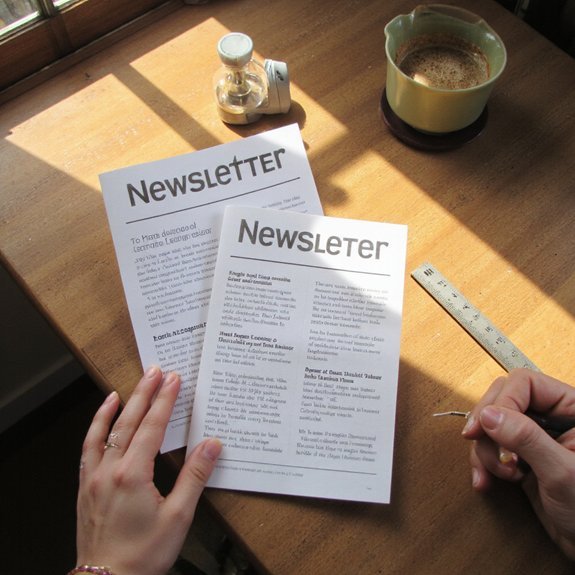You’ll build a newsletter people actually open by defining the exact subscriber you serve, measuring what content they click, and prioritizing value over volume. Use concise formats, test subject lines, and segment based on behavior to boost opens and retention. Start with one clear hypothesis and iterate based on hard metrics…
Key Takeaways
- Define clear subscriber personas (demographics, goals, pain points) and map KPIs to guide content and acquisition decisions.
- Choose a scannable format and optimal length, test modular layouts, and prioritize short chunks and whitespace for easy reading.
- Write subject lines that promise clear value, use verbs and numbers, and A/B test variants for better open rates.
- Deliver value-first content (roughly 70% educational), mix entertaining stories, and limit hard promotions to retain trust.
- Set a reliable cadence, segment lists, track core metrics, and run small experiments to iterate on growth and engagement.
Define Your Ideal Subscriber and Their Needs

Persona work matters: when you define who you’re writing to—demographics, goals, pain points, preferred channels—you make every editorial and growth decision measurable. You map audience personas to concrete behaviors: sign-up triggers, open-rate segments, churn risk. Use quantitative research (surveys, analytics, A/B tests) to quantify subscriber motivations and prioritize content that drives retention and referrals. You create experiments that test headlines, send cadence, and topic mixes against conversion and lifetime value metrics. Build a one-page profile per persona with KPIs: acquisition cost, engagement rate, and average revenue per user. Share these profiles with editorial and product teams so everyone optimizes to the same targets. Iterate quarterly: reassess motivations, friction points, and channel effectiveness. When you measure consistently, you don’t guess — you scale ideas that resonate, reduce waste, and accelerate growth. Report outcomes monthly, tie experiments to revenue, and reallocate resources to high-performing segments and topics annually too.
Choose the Right Format and Length

How long should you make each issue to hit your goals and respect readers’ time? You’ll pick format types that match attention spans and objectives: quick briefs (200–400 words), digest (600–900), or deep-dive (1,500+). Use length strategies driven by open and click metrics; A/B test cadence and size.
| Format | Typical Use |
|---|---|
| Brief (200–400 words) | Rapid updates, high frequency |
| Deep-dive (1,500+ words) | Thought leadership, lower frequency |
Target reader segments with data: measure read rate, scroll depth, and conversion. Iterate: reduce length when engagement drops, expand when retention rises. For innovators, favor modular formats you can recombine—teasers plus optional long reads—so you scale personalization without bloating each issue. Collect quantitative signals (open rate, time-on-page, click-throughs) and qualitative feedback (surveys, comments) to refine format choices and length strategies. Prioritize micro-experiments: change one variable per test, analyze cohort behavior, then roll out winning formats across segments. Track ROI and subscriber LTV continually monthly.
Craft Subject Lines That Get Opens

Three tactics boost opens: lead with clear value, tease curiosity without clickbait, and signal urgency or relevance—then A/B test to see what works for each segment. You should build subject line strategies around measurable intent: use verbs, quantify benefit, and keep length tailored to mobile. Test headline variants against open rate, clicks, and downstream engagement, and iterate on statistically significant winners. Harness emotional triggers sparingly — surprise, relief, and FOMO move readers when aligned with genuine content. Segment by behavior and personalize with dynamic tokens where they increase relevance; avoid static, generic phrasing that lowers trust. Track time-of-day, device, and past engagement to surface the best variant per cohort. When an experiment shows no lift, reframe hypotheses about value or tone rather than tweaking punctuation. Record learnings in a simple playbook so your subject line strategies scale, stay innovative, and continuously improve reader anticipation and deliver measurable ROI.
Design a Scannable, Reader-Friendly Layout
Because most readers scan rather than read linearly, you should structure every newsletter for quick visual parsing: a clear hierarchy, short chunks, and prominent visual anchors (headlines, subheads, images, and CTAs) guide attention and boost click-throughs. Start with a visual hierarchy that signals importance—use bold headlines, concise subheads, and consistent CTA styling so readers instantly know where to act. Break content into two- to four-sentence blocks and use bullets for skimmable steps; experiments show bite-sized items increase retention. Prioritize whitespace balance to reduce cognitive load and make your layout trustworthy. Use a single dominant image or data visual per section to illustrate value without clutter. Limit font families, standardize colors tied to brand affordances, and keep CTA language specific. Test layouts with heatmaps and A/B experiments; iterate based on engagement metrics. When readers can scan and act in seconds, your newsletter becomes a high-performing channel for idea diffusion.
Create a Consistent, Authentic Voice
A consistent, authentic voice builds trust and boosts engagement—newsletters that keep tone and language steady report higher open rates and longer subscriber lifecycles. You’ll define a clear brand personality by documenting vocabulary, sentence rhythm, and preferred attitudes (witty, authoritative, curious) so every issue sounds familiar. Use short style guidelines: do’s, don’ts, sample lines, and 3-tier formality rules for different sections. Measure impact: test subject lines and body tone with A/B experiments, track open, click, and retention lifts tied to tone consistency. Train contributors with one-pagers and quick reviews; automate reminders in your CMS to check voice tags before send. Iterate quarterly using reader feedback and behavior metrics to refine phrasing that resonates. When you keep voice predictable yet evolving, readers recognize you instantly, trust recommendations faster, and engage more reliably — that repeat recognition composes a durable competitive advantage. Prioritize clarity, originality, and measurable voice KPIs monthly reviews.
Balance Value: Education, Entertainment, and Offers
Your newsletter should teach more than it sells—research shows educational content boosts engagement and retention. You’ll keep readers by entertaining with purpose: use storytelling, short visuals, or measured humor that reinforces a useful takeaway. Aim for a simple ratio (for example, 3:1 educational/entertainment to promotional) so you’re building trust before asking for a conversion.
Teach, Don’t Sell
While many newsletters default to pitching, readers engage more with content that teaches: research shows educational emails outperform promotional ones on opens and clicks. You should prioritize a content strategy that delivers actionable insight, not constant offers. Send short lessons, case studies, and curated educational resources that solve immediate problems. Track open and click metrics to iterate topics and format. Use clear CTAs tied to learning — downloads, tools, or micro-courses — not hard sells. Below is a simple cadence you can test:
| Focus | Example |
|---|---|
| Teach | 1 actionable tip |
| Resource | Curated tool list |
Measure lift in retention and referral; optimize frequency to maximize value without fatigue. Experiment with subject lines and preview text to improve discovery and long-term engagement consistently weekly for rapid growth.
Entertain With Purpose
Because subscribers reward variety, aim for a deliberate mix of education, entertainment, and offers—start with a 70/20/10 split (teach/entertain/offer) and test from there. You’ll measure engagement rates, time-on-email, and conversion lift to refine ratios. Use engaging storytelling to turn data or product updates into small narratives that teach and delight. Sprinkle brief interactive content—polls, sliders, tiny quizzes—to boost clicks and collect preference signals. Keep entertainment purposeful: humor or culture references should reinforce learning or prompt action. Track A/B tests and cohort metrics weekly; iterate based on what moves retention and revenue. You’ll preserve trust by making offers minimal, relevant, and clearly tied to value. Over time, calibrated entertainment will raise opens and deepen loyalty. Measure ROI, churn, and referrals to validate creative hypotheses regularly.
Use Calls to Action That Drive Engagement
When you craft CTAs that ask for one specific action, engagement rises — A/B tests often show a 20–40% lift in click-through rates compared with vague or multi-step prompts. You should use concise, actionable wording, prioritize one clear goal, and align CTAs with your content’s promise. Use engaging language and compelling visuals to focus attention and reduce friction. Test verbs (Download, Try, Reserve), placement, and color; measure conversions, not clicks. Provide micro-commitments—small asks that lead to larger actions. Segment CTAs by audience intent: new readers, active subscribers, high-value users. Keep copy short (3–7 words) and explicit about value. Iterate weekly with quick experiments; treat data as your design compass. Below is a quick reference for CTA types and purpose. You’ll learn faster when each test tracks a single KPI.
| CTA | Purpose | Metric |
|---|---|---|
| Download | Lead gen | Downloads |
| Try free | Trial conversion | Sign-ups |
| Read article | Engagement | CTR |
Set a Sustainable Schedule and Send Cadence
If you want consistent results, pick a cadence your team can reliably maintain and your audience will tolerate. Start by auditing capacity: map production time, approval cycles, and analytics. Test sending frequency with small cohorts and measure open, click, and churn rates weekly. Use reader preferences collected via quick polls to adjust timing and content density. Aim for the lowest cadence that meets growth and engagement targets—quality beats volume. Automate repetitive tasks to free creative bandwidth and keep deadlines predictable. Report changes in a dashboard that links cadence to KPIs so stakeholders see cause and effect. Iterate every quarter, not daily, unless signals spike. Communicate schedule expectations to subscribers so delivery feels intentional, not random. That disciplined approach preserves trust, sustains writer momentum, and optimizes ROI for your newsletter program. Measure lifetime engagement shifts to validate cadence decisions and prioritize experiments that move core metrics forward quickly sustainably.
Grow and Segment Your List Strategically
As you scale your list, prioritize channels and segments that move key metrics—conversion rate, CAC, and lifetime engagement—so growth doesn’t outpace value. Focus list growth on high-intent sources: referral programs, gated resources, and partnerships revealed by competitive analysis. Use audience analysis to define priority cohorts, then apply segmentation strategies that combine demographic focus with behavioral signals. Implement targeting tactics that route subscribers into clear paths for content personalization and tailored onboarding. Deploy engagement techniques—micro-surveys, preference centers, and staggered welcome flows—to maintain relevance. Build feedback loops so readers signal content fit and you prune or expand segments accordingly. Maintain list hygiene through regular verification, inactive-subscriber workflows, and suppression rules to protect deliverability and ROI. Keep experiments small and hypothesis-driven, but avoid broad spray-and-pray acquisition. By aligning growth channels, segmentation strategies, and content personalization, you’ll scale an audience that’s both larger and demonstrably more valuable. Stay ruthless about subscriber relevance.
Track Metrics and Run Experiments
Now that you’ve tightened acquisition and segmentation, start measuring the signals that prove your newsletter’s impact and steer experiments. Define core metrics, implement metric tracking, and map engagement rates to content types. Run A/B testing on subject lines, send times, and formats; isolate variables, predefine success criteria, and log results for experiment analysis. Visualize outcomes with clear data visualization—dashboards that combine engagement rates, open-to-click ratios, and conversion events. Compare against performance benchmarks and baseline cohorts to prioritize changes that move the needle. Monitor trends daily but analyze statistically weekly; use trend monitoring to spot persistent shifts and seasonal effects. Collect qualitative user feedback through micro-surveys and interviews to explain quantitative signals. Iterate rapidly: deploy small tests, read experiment analysis, and fold winners into the editorial cadence. Keep hypotheses lean, samples adequate, and reporting transparent so your team makes decisions rooted in data, not hunches. Measure, learn, repeat now.

Leave a Reply